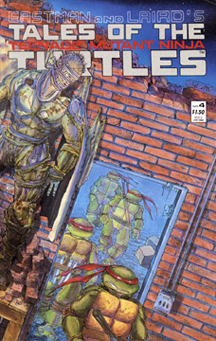“Tales of the Teenage Mutant Ninja Turtles” was an outlet to put out more Turtles comics to meet the increasing demand during the early years of Mirage “Teenage Mutant Ninja Turtles” Volume 1. It also served as the training ground for two Mirage newcomers, penciller Jim Lawson and inker Ryan Brown, both of whom fit nicely with the established pantheon of Eastman and Laird and their first hire, Michael Dooney.
“Tales of the TMNT” Volume 1 ran for seven issues from 1987-89, telling stories that didn’t have to fit with the narrative flow of the main “TMNT.” When the main title itself took on an anthology approach between Issues 22 and 47, “Tales” closed up shop.
Issue 1
Issue 1 (“A Tale of the Teenage Mutant Ninja Turtles”) could’ve just as easily been released as a Casey Jones one-shot. In the spring after the rough winter of “TMNT” No. 11, Casey excitedly shows the Turtles around the beat-up old farmhouse (although come to think of it, shouldn’t they have already been familiar with the place?) even as April bemoans the additional work that will be required to get it up to snuff.

“Tales of the Teenage Mutant Ninja Turtles” Issues 1-7 (1987-89)
Titles: “A Tale of the Teenage Mutant Ninja Turtles” (No. 1), “Nobody’s Fool!” (No. 2), “All Hallow’s Thieves” (No. 3), “I, Monster” (No. 4), “Complete Carnage and Radical” (No. 5), “Leatherhead” (No. 6), “The Return of Savanti Romero!” (No. 7)
Writers: Kevin Eastman, Peter Laird, Ryan Brown
Pencils: Jim Lawson
Inks: Ryan Brown
Casey’s insane cousin comes by with his hick buddies to harass Casey about a supposed buried treasure on the property, and the Turtles kick their butts. I wish “Tales” would’ve done more character pieces like this, as I love how the portrayal of Casey’s new “family” is so much more familial than his actual family. (Makeshift family is also a theme of the 1990 movie.)
Issue 2
Superhero-obsessed Peter Laird is almost certainly responsible for the invention of Nobody, a black-clad detective who lurks in the shadows and secretly helps Springfield cops in Issue 2 (“Nobody’s Fool!”). I’m not sure what he adds to the genre or to the TMNT mythos; frankly, I’d rather have seen the Turtles get wrapped up in a crime detection plot on their own, as opposed to basically just watching Nobody’s adventure.
Issue 3
Issue 3 (“All Hallow’s Thieves”) could serve as traditional Halloween “TMNT” reading the same way “Michaelangelo” and “Leonardo” do for Christmas, although it’s not on that level. It’s a fun romp centering on a magic-user who uses a statue stolen from the Second Time Around shop to release tiny winged demons in NYC.

The downside is that it’s not particularly scary; maybe horror comics just aren’t in the Mirage gang’s wheelhouse (although, come to think of it, the next issue has somewhat of a horror vibe). I do like the idea that Halloween is the only day the Turtles can go out in public, as everyone assumes they’re wearing costumes.
Issue 4
My two favorite “Tales” comics are Issues 4 (“I, Monster”) and 6 (“Leatherhead”) because they introduce the Rat King and Leatherhead, both of whom were action figures and cartoon characters. Brown adds a lot to “I, Monster” with his introductory note about his young adult years in Cleveland. He lived across from a cluster of abandoned factories, and wondered what lurked in the shadows of those buildings.
Lawson lifts the setting for this issue (set in a run down section of Northampton, or possibly another Massachusetts town), narrated by an increasingly insane loner who roams the swamps and drops animals into a columnar building for rats to feast on. It makes for a great final-act battle spot, and it’s a nice twist when the injured man falls to his supposed doom, but is befriended by the rats, rather than eaten alive. He has become the Rat King.
Issue 5
When you consider issues like No. 5 – where title characters Complete Carnage and Radical battle in the skies of NYC for everyone to witness — you have to wonder why the Turtles obsess about staying undercover. A more nuanced take on “Complete Carnage and Radical” is explored in “Star Wars: The Clone Wars’ ” Mortis trilogy.
Two humans are given mutant superpowers by simultaneous lighting strikes: Complete Carnage – a male construction worker who now looks like a monster — is pure evil, Radical – a female jogger who retains her human look — is pure good. Their purpose in life is now to fight each other.
Issue 6
We saw TCRI aliens (Utroms) scouring the sewers for Earth specimens back in Issue 3 of the main title when they picked up Splinter. We learn in “Tales” 6 that they also picked up an alligator and accidentally mutated him. If you remember fighting Leatherhead as an end boss in “TMNT III: The Manhattan Project,” or watching the Southern-drawling gator terrorize the Punk Frogs in the cartoon, you’ll be surprised to find that he’s civil and friendly in his original incarnation.
After he and the Turtles escape a big-game hunter, Leatherhead accepts the Turtles’ invitation to move into their original sewer lair. And the mutant gator is thus in place for future adventures, especially if they involve the Utroms, whom Leatherhead views as father figures.
Issue 7
Dinosaur enthusiast Laird must have been the driving force behind Issue 7 (“The Return of Savanti Romero!”) as timestress Renet returns to enlist the Turtles’ help in her ongoing battle with Romero during the Cretaceous Period. Or maybe it was the brainchild of Lawson, also a dinosaur nut. Romero remains a cartoonish baddie, and Renet’s immaturity isn’t quite as funny as back in Issue 8 of the main title, but hey, it’s an excuse to see Raphael fight a T-rex and Donatello take on a velociraptor.
Final thoughts
Ultimately, “Tales” is a mixed bag that no doubt produced many different rankings of the issues depending on the reader’s taste. While I’m partial to mutants and Earthly (albeit weird) humans like Leatherhead and the Rat King — who in my opinion fit organically into the Turtles’ world — other fans love superheroes and superpowered mutants, who in my opinion feel like unwelcome guests on the Turtles’ turf.
By 1989, five years after the invention of TMNT, Eastman and Laird had opened up the saga for better and worse. Better because a reader knows just about anything can happen in a “TMNT” book. Worse because sometimes the writers’ imaginations run so wild that they forget to slow down and let the characters and story points develop.
In the 2000s, “Tales” Volume 2 would also be a grab bag of concepts, but the best issues would do something that I wished more of these early issues would have: Dig into nuances of character and story.

